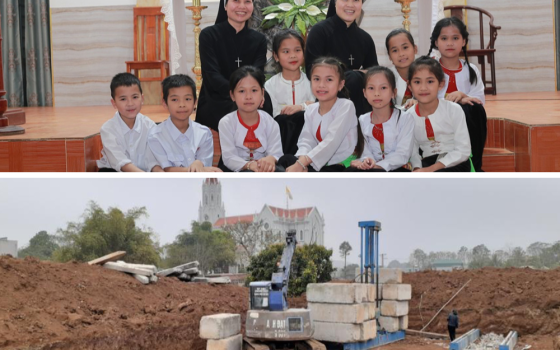Leroy Hollow is a forested valley in southern Missouri near the Trappist Assumption Abbey. It winds several miles from Hilo Ridge down to Bryant Creek, a clear-flowing, rock-bottomed Ozark waterway.
A spring-fed stream shaded by spicebush and pawpaw trees runs down the hollow’s center. Its banks are carpeted with bloodroot, trillium and other wildflowers. In autumn the tinted leaves in the forest canopy filter the sun overhead like stained glass.
The hush and silence of the place could be bottled and sold to noise-addled city dwellers.
 Leroy Hollow’s beautiful trees suffered two assaults in the last century. In the 1910s loggers cut down the oaks, then hewed them into railroad ties, hauling them out with horses. In the 1970s loggers returned with chainsaws and toppled many of the children of the first assault, sending them to hardwood flooring mills. Government forestry experts advised the loggers on how to maximize profits.
Leroy Hollow’s beautiful trees suffered two assaults in the last century. In the 1910s loggers cut down the oaks, then hewed them into railroad ties, hauling them out with horses. In the 1970s loggers returned with chainsaws and toppled many of the children of the first assault, sending them to hardwood flooring mills. Government forestry experts advised the loggers on how to maximize profits.
Now a different kind of forest expert, David Haenke, walks the hollow, marking trees for local loggers to harvest.
Haenke’s forest project will eventually protect more than 3,500 acres and demonstrate ecological management and sustainable harvesting of native forests. He has given a presentation on forest management to the Trappist monks nearby, who live and pray in the midst of thousands of acres of prime forestland.
Haenke has a vision: “The land where I work is in the watershed of a beautiful Ozark stream called Bryant Creek. Back in 1977 I had a vision to create ‘The Bryant Creek Nation,’ where caring people would get all the land in the 40-mile watershed into an ecological trust. A big dream, but one worth having.”
Haenke believes that every single thing humans need to do in order to survive and thrive can and must be done according to the ecological laws and design principles given freely, directly and almost eternally by the Earth. “This is nothing new,” he says. “It’s how humans have seen and done things throughout the bulk of history, except during the industrial insanity of the last 500 years.”
David Haenke is more than a forestry expert. He helped start the bioregional movement back in the 1970s.
Bioregionalism is an emerging field in the new ecological worldview. It’s concerned with reshaping our understanding of human identity in relationship to place, to ecosystem and to nature. We need to learn to understand ourselves in relationship to place and to the story of that place.
The bioregionalists advocate replacing the man-made, historically arbitrary political boundaries of nations, states and counties. They suggest instead using natural ecosystem features, such as watersheds, mountain ranges and entire biotic communities, human and nonhuman, as the defining features of a given region.
Important values are not property rights and development but rather preserving the integrity of the regional ecosystem and maximizing its economic self-sufficiency. Political control would rest with the community of people actually living in the region. This is the concept of “reinhabiting.”
“Most of the wealth of this forest was looted,” Haenke observed. “It’s coming back, but slowly. Meanwhile what is here is, in terms of dollar value, vastly underpriced. The value of trees here swims in the sea of the global economy, where commodity and labor prices are driven down to absurd lows, liquidation prices, in order to stuff the multinational feeding frenzy.
“The value of a log tree here has to compete against land virtually given away and harvested by near slave labor in the Amazon, Indonesia, Malaysia. It’s a rigged game. The way out is through innovative forestry practices that honor the ecosystem here.”
Bioregionalism picks up where environmentalism leaves off. Poet and farmer Wendell Berry writes: “The question that must be addressed is not how to care for the planet but how to care for each of the planet’s millions of human and natural neighborhoods, each of its small pieces and parcels of land, each one of which is in some precious way different from all the others.”
Bioregionalism is a fancy name for living a rooted life. Sometimes called “living in place,” bioregionalism means you are aware of the ecology, economy and culture of the place where you live and are committed to choices that enhance them.
Actions that reflect a bioregional approach to living and spending include:
-- Buying food grown locally and organically.
-- Avoiding large chain retailers in favor of locally owned stores.
-- Knowing the birds, animals, trees, plants and weather patterns of your place, as well as land features and soil types.
-- Seeking out entertainment that originates in your area; supporting local artists, musicians, theater companies, storytellers.
-- Knowing where your garbage goes and reducing your waste to a minimum.
-- Knowing where your drinking water comes from and using water conservatively.
-- Knowing how and where your electricity is generated and utilizing sustainable energy sources, such as solar power, and conservation measures, such as compact fluorescent light bulbs, whenever possible.
This is a worldview that gets little hearing when the economic infrastructure is attuned entirely to growth, development, innovation, and "creative" destruction. Not much value placed is placed upon carefully tending to, exploring, being humbled by, and getting to know the natural history of a place.


